|
|





 iven its relative proximity to the harbour entrance of St.John’s, Quidi Vidi was probably the site of some of the
Colony’s earliest defence works as it formed a natural part of the outer ring of defenses of St.John’s. It’s most
prominent role however was in the events surrounding the capture of St.John’s by a French force in 1762. iven its relative proximity to the harbour entrance of St.John’s, Quidi Vidi was probably the site of some of the
Colony’s earliest defence works as it formed a natural part of the outer ring of defenses of St.John’s. It’s most
prominent role however was in the events surrounding the capture of St.John’s by a French force in 1762.
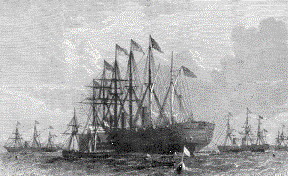 In the spring of that year a French fleet commanded by Count d’Haussonville, sailed from Brest, France with a force
numbering over seven hundred intent on the capture of St.John’s which was the key to the lucrative fishing trade.
Having suffered the loss of Quebec and Montreal, the French were eager to gain a strong bargaining position in the
expected talks to end the Seven Years War. In the spring of that year a French fleet commanded by Count d’Haussonville, sailed from Brest, France with a force
numbering over seven hundred intent on the capture of St.John’s which was the key to the lucrative fishing trade.
Having suffered the loss of Quebec and Montreal, the French were eager to gain a strong bargaining position in the
expected talks to end the Seven Years War.
The French Squadron, consisting of our ships of war landed at Bay Bulls on 24 June where the troops were quickly
disembarked and engaged in a speedy march toward the town. The garrison in St.John’s numbered less than seventy men.
When French forces arrived on the 27th the British troops had no choice but to surrender.
The French Commander immediately set about repairing and constructing additional defense works which included a
makeshift for on Signal Hill and a defense battery or breastwork at the mouth of Quidi Vidi harbour.
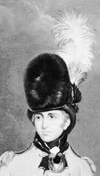 When news of the capture of St.John’s reached the English Ministry immediate steps were taken to order General
William Amhearst, Commander of the 32nd Regiment in New York, to proceed directly to Louisbourg where additional
troops were to be amassed for the recapture of St.John’s. By the 11th of September, the British fleet under Lord
Colville, was anchored off the narrows of St.John’s. The troop transports carrying Amhearst’s force included over
fifteen hundred soldiers composed of Companies from the Royal Scots, the 77th Montgomery Highlanders, the 78th
Frazer Highlanders, and a contingent of Royal Americans, afterwards the 60th Rifles. When news of the capture of St.John’s reached the English Ministry immediate steps were taken to order General
William Amhearst, Commander of the 32nd Regiment in New York, to proceed directly to Louisbourg where additional
troops were to be amassed for the recapture of St.John’s. By the 11th of September, the British fleet under Lord
Colville, was anchored off the narrows of St.John’s. The troop transports carrying Amhearst’s force included over
fifteen hundred soldiers composed of Companies from the Royal Scots, the 77th Montgomery Highlanders, the 78th
Frazer Highlanders, and a contingent of Royal Americans, afterwards the 60th Rifles.
Commodore Lord Colville, a frequent visitor to the Island, suggested proceeding to Torbay having seen, “a redoubt or
something like one was raised at Quidi Vidi.”
Colonel Amhearst landed on the 13th of September, seven miles to the northward of St.John’s, having experienced little
opposition during landing from the enemy; and pushing forward, took possession of the strong post of Quidi Vidi
despite sharp resistance from its French defenders who subsequently retreated to the summit of Signal Hill.
Throughout the next day, the Quidi Vidi channel was opened up, as the French had sunk several shallops at the mouth
of the harbour to prevent landings, and all military equipment and supplies were loaded aboard transports and sailed
from Torbay to Quidi Vidi where they were offloaded in preparation for the assault on the town.
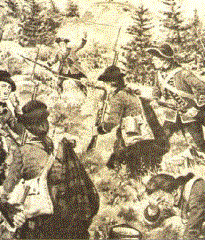 Leaving the defense works at Quidi Vidi on the 15th, a detachment of British troops was able to reach the summit of
Signal Hill under the cover of thick fog and remained undiscovered by French sentries until to late. Despite the
loss of several men, the British were able to secure the hill and the French defenders fell back to Fort William below. Leaving the defense works at Quidi Vidi on the 15th, a detachment of British troops was able to reach the summit of
Signal Hill under the cover of thick fog and remained undiscovered by French sentries until to late. Despite the
loss of several men, the British were able to secure the hill and the French defenders fell back to Fort William below.
On the 17th, a battery consisting of 4 twenty-four pounders and 2 twelve pounders fired on Fort William only 400
feet below. Having intelligence that the French Commander intended to blow up the fort before quitting it, Amhearst
threatened it commander by vowing to “ put every man to the sword” should the fort be destroyed. After enduring a
night of bombardment, Count d’Haussonville, the Commander of French troops, surrendered by capitulation. The enemy’s
fleet, taking advantage of a heavy fog, had made their escape two nights before.
Over 800 French prisoners of war were rounded up and within the month transports were arranged by Lord Colville to
carry them back to Brest, France. The recapture of St.John’s had cost the British less than fifty wounded or killed.
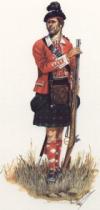 With the departure of the French the British began an ambitious construction of defense works and installations.
Fort William was rebuilt, a Queen’s Battery was commenced on Signal Hill and a new fort was erected on the South
Side of the Narrows. Quidi Vidi Battery was not overlooked in these new defense works. In 1775, with the outbreak
of the American Revolutionary War, the Battery was rebuilt and a gun placement was installed consisting of 4 eighteen
pounders and 2 six pound cannons. By 1784 the site was again abandoned only to be refurbished at the outbreak of the
Anglo American War of 1812. With the departure of the French the British began an ambitious construction of defense works and installations.
Fort William was rebuilt, a Queen’s Battery was commenced on Signal Hill and a new fort was erected on the South
Side of the Narrows. Quidi Vidi Battery was not overlooked in these new defense works. In 1775, with the outbreak
of the American Revolutionary War, the Battery was rebuilt and a gun placement was installed consisting of 4 eighteen
pounders and 2 six pound cannons. By 1784 the site was again abandoned only to be refurbished at the outbreak of the
Anglo American War of 1812.
The Quidi Vidi Battery continued to garrisoned throughout the mid 1800’s first by the Royal Artillery and finally
by Infantry soldiers from the Royal Newfoundland Companies who formed the Imperial Garrison until the eventual
departure of all British troops from the Colony in 1870. After that time the Battery fell into eventual disarray.
Quidi Vidi Battery Restoration and Interpretive Display
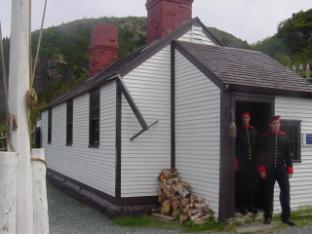 In 1967, the 56 Field Engineer Squadron decided to rebuild the Quidi Vidi Battery as a project to mark Canada’s Centennial Year. All that remained of the original site was partial sections of the foundation which were uncovered in the initial digs. Exploratory trenches were dug in order to determine the outline of the original facility. Excavated materials were screened for artifacts and the process of clearing the overgrowth was begun by up to twenty sappers a day. The Guard House, which measured 30’ X 15’ was rebuilt. Many of the bricks found on the site were used to reconstruct the fireplaces, ovens and chimneys. Doors and fasteners were forged at a local foundry. Having completed the Guard House, the Engineers next laid the gun deck constructed of two by eight planking butted with ten inch square timbers. The gun platform, when completed, measured seventy feet by twelve feet and featured four gun ports where two carronades and two six pound cannons were mounted. Finally the powder magazine was completed with fourteen inch thick concrete walls and a reinforced wooden door. In 1967, the 56 Field Engineer Squadron decided to rebuild the Quidi Vidi Battery as a project to mark Canada’s Centennial Year. All that remained of the original site was partial sections of the foundation which were uncovered in the initial digs. Exploratory trenches were dug in order to determine the outline of the original facility. Excavated materials were screened for artifacts and the process of clearing the overgrowth was begun by up to twenty sappers a day. The Guard House, which measured 30’ X 15’ was rebuilt. Many of the bricks found on the site were used to reconstruct the fireplaces, ovens and chimneys. Doors and fasteners were forged at a local foundry. Having completed the Guard House, the Engineers next laid the gun deck constructed of two by eight planking butted with ten inch square timbers. The gun platform, when completed, measured seventy feet by twelve feet and featured four gun ports where two carronades and two six pound cannons were mounted. Finally the powder magazine was completed with fourteen inch thick concrete walls and a reinforced wooden door.
The Quidi Vidi Battery was reconstructed in 1967 to resemble a British Coastal Battery of the turn of the century period.
Accounts suggest that the Quidi Vidi Battery was home to a small detachment of Royal Artillery Gunners.
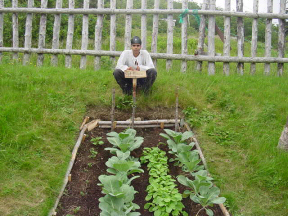 The Guard House was reconstructed with two separate rooms. The inner chamber was thought to be home to the
NCO who was likely a Corporal while the outer barrack room housed two to four or more artillery gunners or
infantry soldiers. The Guard House was reconstructed with two separate rooms. The inner chamber was thought to be home to the
NCO who was likely a Corporal while the outer barrack room housed two to four or more artillery gunners or
infantry soldiers.
In addition to their regular training and unending sentry duty, it was likely that the men of t he Quidi Vidi
Battery were required to work for the Army, doing many different jobs. They were often employed to build public
roads or other public works in the area for which they were paid one penny per hour, or on occasion, the equivalent
in rum. This money was given in addition to their daily salary of one shilling. The soldiers, however,
rarely saw this amount of money due to deductions call off-reckonings. The men were deducted for the food
they ate, the shelter in which they slept, and most of the clothing they wore. The men rarely received more
than a few pennies and most were in debt.
Furnishings and Fitments
Furnishings and fitments refer to those items allocated to a Battery such as tables, forms, shelving, beds and bedding,
fireplace and fixtures, lighting and sanitation and cleaning supplies as opposed to all other equipment which a
soldier would bring with him while stationed there.
Tables/Forms
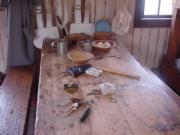 Barrack regulations required that each barracks be equipped with a 6’ table of pine. Forms or benches were
also authorized and were made of pine. Tables and benches were required to be frequently cleaned and in
most cases were easily moveable to provide extra space. Barrack room layouts from the period suggest that
both the table and the forms were usually made with legs of iron however the Quidi Vidi Battery site has
been constructed wholly of wood. Barrack regulations required that each barracks be equipped with a 6’ table of pine. Forms or benches were
also authorized and were made of pine. Tables and benches were required to be frequently cleaned and in
most cases were easily moveable to provide extra space. Barrack room layouts from the period suggest that
both the table and the forms were usually made with legs of iron however the Quidi Vidi Battery site has
been constructed wholly of wood.
Fireplace/Fixtures
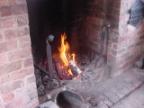 The Quidi Vidi Battery features two fireplaces located in each of the inner room and the outer chambers which were
used for heating and cooking purposes. A number of fireplace fixtures are displayed including a poker, shovel,
tongs, andirons. As the fireplace was used for cooking a crane is also displayed to vary the distance of the
foodstuffs from the open flame. In addition, the outer chamber fireplace features an offset oven for baking
bread or biscuit. Displayed at the foot of the fireplace is the coal tray and ash box both of which would
have been painted common grey. The Quidi Vidi Battery features two fireplaces located in each of the inner room and the outer chambers which were
used for heating and cooking purposes. A number of fireplace fixtures are displayed including a poker, shovel,
tongs, andirons. As the fireplace was used for cooking a crane is also displayed to vary the distance of the
foodstuffs from the open flame. In addition, the outer chamber fireplace features an offset oven for baking
bread or biscuit. Displayed at the foot of the fireplace is the coal tray and ash box both of which would
have been painted common grey.
Barracks Beds
The Quidi Vidi Barracks, like most other small batteries found throughout British North America was comprised of little
more than four walls for sleeping quarters. The often cramped space provided little room for comfort, entertainment or privacy.
The most common type of military bed used during the period was the birth. Depending on the size of the room, this
bed was constructed with one or two tiers.
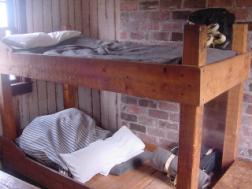 More often than not, two soldiers slept on each tier making the berths necessarily large. Each had to be assembled
inside the barracks room, and since they could not be removed through the door without disassembling them, the berths
were considered by the Barrack Department as architectural fittings, rather than furniture. More often than not, two soldiers slept on each tier making the berths necessarily large. Each had to be assembled
inside the barracks room, and since they could not be removed through the door without disassembling them, the berths
were considered by the Barrack Department as architectural fittings, rather than furniture.
It is difficult to determine the exact construction details of each berth. What is known is that the materials
used usually consisted of 4 inch square pine for the posts, 1 ˝ inch pine boards for the rest and hammered together
with 20d nails. Each berth was to have removable bottom boards laid width wise. Berths in the Quidi Vidi Battery
are constructed of solid pine and each berth contains twenty two cross boards. The boards from the centre of the
berth down to the feet were removed each morning by the soldiers. This was designed to prevent soldiers from
sitting on their berths during the day. In many cases, these boards were in such a bad state from long use, that
the men sleeping in the top berths often fell through on those in the lower ones. Berths were in poor condition
in many garrisons, showing rot, missing parts and infested with insects. Those barracks that were whitewashed as
per regulations fared much better.
Bedding
Bedding is a general term referring to five separate items: a bolster, a palliasse, sheets, blankets, and a rug.
Berths as the Quidi Vidi Battery illustrate each of these items except for the rug which is largely unavailable
as a reproduction item.
Bolster
The bolster was the pillow which was issued by the Barracks Department. It measured 1 ˝ feet by 4 ˝ feet and was
stamped with a “GR” in each corner to establish tem as government property. One bolster per berth was supplied.
Each bolster was filled with straw and closed with tie lines.
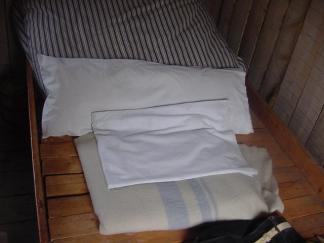 Palliasse Palliasse
The pallaisse was the bed case or covering. It measured 6’ by 7 ˝ ‘ and was also stamped with the GR to
distinguish government ownership. Usually the pallaisse was filled with 36 pounds of straw which was
supplied and replenished every three months. When not in use, and for daily inspection, the palliasse was
doubled once from the length and strapped in the center with bolster and sheets on top.
Sheets
Each berth was also issued two linen sheets measuring 6’ by 7’ which were hemmed along the edges.
Sheets were folded three times and doubled over from length and placed on the folded palliasse underneath the blankets.
Blankets/Rug
Blankets were supplied at two per berth. They were made of wool and measured 6’ by 7 ˝ ‘. Woolen blankets
were made in Whitney, England and were supplied to the army in large quantities. It was general practice for
soldiers to carry their issued blankets while on campaign. The Barracks Department also issued green knotted
rugs as part of required bedding however this item is not available at the Quidi Vidi Battery.
Care/Cleaning
Caring for bedding was a daily activity of each soldier. After rising in the morning, the men were expected to
shake and fold up their bedding. After morning parade, the bedding was ordered to be taken out and aired in
the barracks yard. At this point the pallaisses were expected to be beaten with a stick. After dinner the bedding
was brought back in and arranged as it had been in the morning. Explicit orders were given for the bedding never
to be used for sitting upon, nor the sheets for wiping hands, nor the blankets for ironing linen and that no wearing
apparel was to be kept under the bedding.
Washing and repair of the bedding was regulated as well: sheets to be washed once a month, palliasses and bolsters
once every three months, and blankets and rugs once a year.
Shelving and Musket Bands
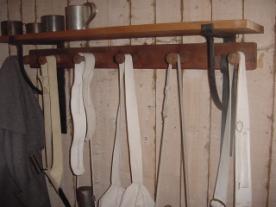 Barrackmaster regulations allotted each man a shelf and pegs on which to store his uniform and accouterments.
Usually each soldier was allotted three pegs with a shelf about measuring 1 ˝ “ deep and 12” wide. Webbing was
stored on the pegs while other accouterments such as headdress, and knapsack, were stored on the shelf. A musket
band was also provided which allowed for the musket to be stored upright for immediate use. These wooden pegs and
shelves are currently part of the Quidi Vidi Battery Display. Barrackmaster regulations allotted each man a shelf and pegs on which to store his uniform and accouterments.
Usually each soldier was allotted three pegs with a shelf about measuring 1 ˝ “ deep and 12” wide. Webbing was
stored on the pegs while other accouterments such as headdress, and knapsack, were stored on the shelf. A musket
band was also provided which allowed for the musket to be stored upright for immediate use. These wooden pegs and
shelves are currently part of the Quidi Vidi Battery Display.
Lighting
 Lighting was provided by open candle and lantern. Soldiers were most often issued dip candles which were strictly
controlled. Both the open candle and the wind lantern are on display at Quidi Vidi Battery. Lighting was provided by open candle and lantern. Soldiers were most often issued dip candles which were strictly
controlled. Both the open candle and the wind lantern are on display at Quidi Vidi Battery.
Messing
Each Company of soldiers in the British Army was divided up into messes which allowed men to pool their rations and rotate
as cooks. Messes were established to ensure that the soldier did not starve himself or squander his meal money away on gambling or drink.
The size of each mess varied considerably depending on whether the unit was in barracks or in the field.
Some regiments envisioned the ideal mess size to be between ten and eighteen men, while others practiced messing as an entire Company.
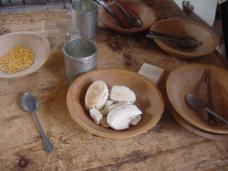 Married soldiers were usually permitted to pool their rations with their families, apart from the company messes.
These rations were limited to twelve women and their children per Company stationed on foreign service. In the case
of unmarried soldiers, each mess had a head or president. He was a corporal, chosen man or older soldier, and his
responsibility was to ensure that the men sat down to dinner dressed as soldiers and that each was in possession of
a fork, knife, spoon, and plate. Regardless of rank, each soldier contributed six to six and a half pence a week
to the mess to cover expenses such as messing utensils not provided by the Barracksmaster. Married soldiers were usually permitted to pool their rations with their families, apart from the company messes.
These rations were limited to twelve women and their children per Company stationed on foreign service. In the case
of unmarried soldiers, each mess had a head or president. He was a corporal, chosen man or older soldier, and his
responsibility was to ensure that the men sat down to dinner dressed as soldiers and that each was in possession of
a fork, knife, spoon, and plate. Regardless of rank, each soldier contributed six to six and a half pence a week
to the mess to cover expenses such as messing utensils not provided by the Barracksmaster.
To track the expenses and charges against each soldier a Company weekly mess book was kept. This book contained an
account of the expenditure of that part of the soldier’s pay, which was appropriated for messing.
Throughout the day, the soldiers probably ate only two meals. At 9:30 a.m. the men ate breakfast which might
consist of an oatmeal porridge. At 1:00 p.m. the soldiers ate the main meal This meal was usually salt pork or
salt beef stew with vegetables only when they were in season. Bread also accompanied this meal although butter
was not provided.
Meat was prepared in one of two ways: boiled and roasted, or baked. Sometimes oatmeal and potatoes were included
with the meat into soups or bouille. Other favoured vegetables in the soldier’s diet included cabbage, peas, and
beans, and each were prepared as the cook saw fit.
Supplementing meat with fish was common practice for soldiers stationed in British North America. Generally, fish
consumption was frowned upon by the military because it was not generally fresh and resulted in undo illness.
Hunting was also practiced by the soldier adding undomesticated meat to his diet. Soldiers could also purchase
vegetables from various gardens in and around St.John’s.
While each barrack was supplied a fixed number of tin cups, plates, and soup and water pails, each soldier was
expected to purchase his own knife, fork and spoon. These were considered necessaries and would be kept in their own knapsack.
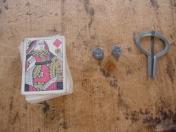 Playing cards and rolling dice were two forms of entertainment which involved gambling for rum. Music was a way
of passing time and boosted the morale of the men. Penny whistles, also known as tin whistles, were inexpensive
and easy to play, so many soldiers would have them. Playing cards and rolling dice were two forms of entertainment which involved gambling for rum. Music was a way
of passing time and boosted the morale of the men. Penny whistles, also known as tin whistles, were inexpensive
and easy to play, so many soldiers would have them.
Although this life seems very harsh, many men chose the army as their livelihood. In England there was widespread
unemployment due to the Industrial Revolution. Because of this men turned to the army which offered a secure
job, food, clothing, and shelter.
Uniforms and Accouterments
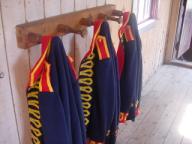 While uniforms in the British Army varied widely depending on the Regiment, the soldiers basic accouterments changed
little from the early 1800’s to the introduction of the Valise Equipment of 1871. While uniforms in the British Army varied widely depending on the Regiment, the soldiers basic accouterments changed
little from the early 1800’s to the introduction of the Valise Equipment of 1871.
Uniform
The uniform worn by the Royal Artillery while in the Newfoundland Station was of Royal Blue with red facings.
The pants were generally white for home service while grey was adopted in foreign service.
Shako
 Shakos were made of stout felt with a stamped brass plate with the Royal Artillery cypher. The plates were of universal
pattern often with the Regiments own badge stuck in the center to replace the Royal Cypher. Shakos were made of stout felt with a stamped brass plate with the Royal Artillery cypher. The plates were of universal
pattern often with the Regiments own badge stuck in the center to replace the Royal Cypher.
Shirts
Shirts were annually issued to each soldier as part of his necessaries, the cost of which was deducted from his pay.
Commonly, army shirts were made of white linen. In addition to this, soldiers stationed abroad, in the field, or in
harsher climates were issued or purchased shirts made out of other more durable or warmer materials such as flannel.
Soldiers were also often issued with a number of “false collars”, also termed as turn overs, or turn downs.
Trotter Knapsack
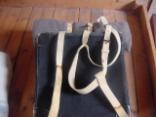 Before 1805 the British soldier was issued a canvass knapsack which was rounded at the ends. In that year, the
Trotter Knapsack was first introduced and was quickly adopted as t he official British knapsack. The Trotter model
was made of black lacquered canvass reinforced at the corners with squares of leather. To give the knapsack a
rectangular appearance it was fitted with board at the top, bottom and sides. The rigid wooden framework coupled
with the excessive weight of other accouterments plagued the soldiers during punishing marches. The Trotter Knapsack
was worn on the back by shoulder straps which extended around the arms and at the waist. The Trotter Knapsack was
perhaps the most poorly designed piece of kit worn by 19th century British soldiers. Before 1805 the British soldier was issued a canvass knapsack which was rounded at the ends. In that year, the
Trotter Knapsack was first introduced and was quickly adopted as t he official British knapsack. The Trotter model
was made of black lacquered canvass reinforced at the corners with squares of leather. To give the knapsack a
rectangular appearance it was fitted with board at the top, bottom and sides. The rigid wooden framework coupled
with the excessive weight of other accouterments plagued the soldiers during punishing marches. The Trotter Knapsack
was worn on the back by shoulder straps which extended around the arms and at the waist. The Trotter Knapsack was
perhaps the most poorly designed piece of kit worn by 19th century British soldiers.
Italian Canteen
 The canteen or water bottle was generally issued to troops, by the Board of Ordnance, during campaigns. Canteens
were also issued to soldiers in barracks. The standard British canteen was the Italian model which was similar
to a small wooden keg. It was bound by a metal ring and had a leather sling which was worn on the left side.
The outer face of the canteen was painted blue often with the regimental number inscribed. While in marching
order the canteen tended to bounce about and more frequently than not it tended to leak as well. A full canteen
weighed about three pounds. The canteen or water bottle was generally issued to troops, by the Board of Ordnance, during campaigns. Canteens
were also issued to soldiers in barracks. The standard British canteen was the Italian model which was similar
to a small wooden keg. It was bound by a metal ring and had a leather sling which was worn on the left side.
The outer face of the canteen was painted blue often with the regimental number inscribed. While in marching
order the canteen tended to bounce about and more frequently than not it tended to leak as well. A full canteen
weighed about three pounds.
Haversack
 The haversack was also a campaign issue. Made of canvass or course linen it was designed to carry a soldier’s rations
during extensive marches. Usually the soldier carried rations enough for three days. Often the haversack became an
aid to foraging when soldiers were required to live off the land. Like the canteen it was worn on the left side by
a sling which also served to restrict the soldier’s free movements. The haversack was also a campaign issue. Made of canvass or course linen it was designed to carry a soldier’s rations
during extensive marches. Usually the soldier carried rations enough for three days. Often the haversack became an
aid to foraging when soldiers were required to live off the land. Like the canteen it was worn on the left side by
a sling which also served to restrict the soldier’s free movements.
The Cartridge Pouch
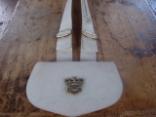 Artillery detachments wore a white buff leather cartridge pouch hung by a strap over the right side. Cartridges
were issued to soldiers in groups of ten and were then fitted in the cartridge pouch in wooden separators.
The badge on the artillery pouch was made of brass and was backed by red leather. Unlike the infantry, artillery
pouches held fewer cartridges and the sling featured loops for vent pricks and primers. Artillery detachments wore a white buff leather cartridge pouch hung by a strap over the right side. Cartridges
were issued to soldiers in groups of ten and were then fitted in the cartridge pouch in wooden separators.
The badge on the artillery pouch was made of brass and was backed by red leather. Unlike the infantry, artillery
pouches held fewer cartridges and the sling featured loops for vent pricks and primers.
The Mess Tin
The standard British mess tin was the “D” section or Kidney mess tin. It was carried in an oilskin cover and
attached to the Trotter Knapsack.
The Short Land Model Brown Bess Musket
The “Brown Bess”, a flintlock musket, was the main weapon of the British Army dating from the 1730’s. The first model
Brown Bess or Long-Land Musket had a 46 inch barrel with a wooden rammer retained by three pipes of equal size and a
tail piece where it entered the stock. Another pattern of which there is increasing mention from 1740 onwards is the
Short Land Musket, with the same style of stock, lock and furniture as the Long model but with a 42” barrel.
While the Brown Bess was slow to load, highly inaccurate and frequently unreliable, a well trained soldier could prime,
load and fire three times in one minute. This involved a 12 step process in order to fire just one shot. The musket
fired lead balls which were propelled by a black powder charge. Black powder is a mixture of saltpeter, brimstone,
and charcoal. At short ranges, these lead balls could inflict horrible damage on soldiers as they did not pierce a
person body but rather smashed against it. It was often said that soldiers did not aim their weapons instead they
pointed them in a general direction and hoped for the best. The bayonet for the Short Land model was a 17”
triangular shape held in a leather scabbard.
Ordnance
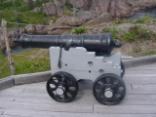 There are currently two 42pdr carronades on site at the Quidi Vidi Battery. Carronades are short light pieces of
ordnances which are enlarged at the bore to acco mmodate various forms of shot. Their size and weight make them
ideal for shipboard use. Carronades were developed by the Carron Company in Falkirk, Scotland and were first
introduced in 1778. There are currently two 42pdr carronades on site at the Quidi Vidi Battery. Carronades are short light pieces of
ordnances which are enlarged at the bore to acco mmodate various forms of shot. Their size and weight make them
ideal for shipboard use. Carronades were developed by the Carron Company in Falkirk, Scotland and were first
introduced in 1778.  They were cast in calibers from 3 to 68 pounders. They were cast in calibers from 3 to 68 pounders.
In addition, two iron 6 pdr, mounted on wooden garrison carriages, are currently on site at the Quidi Vidi Battery.
|




| | |
|

